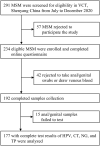Patterns of Sexually Transmitted Co-infections and Associated Factors Among Men Who Have Sex With Men: A Cross-Sectional Study in Shenyang, China
- PMID: 35712312
- PMCID: PMC9193278
- DOI: 10.3389/fpubh.2022.842644
Patterns of Sexually Transmitted Co-infections and Associated Factors Among Men Who Have Sex With Men: A Cross-Sectional Study in Shenyang, China
Abstract
Background: Men who have sex with men (MSM) are disproportionately affected by sexually transmitted infections (STIs). We sought to describe patterns of sexually transmitted co-infections and explore factors associated with increased acquisition of STIs among MSM.
Methods: We enrolled MSM in Shenyang, China, between July and December 2020 to test for four STIs, including human papillomavirus (HPV), Chlamydia trachomatis (CT), Neisseria gonorrhoeae (NG), and Treponema pallidum (TP). Data regarding demographic and behavioral characteristics of participants were collected through a self-administered digital questionnaire. We adopted the ordinal logistic regression model to identify factors associated with acquiring more STIs.
Results: Overall, 177 participants with completed test results for all four STIs were analyzed. These participants had a median age of 29.0 (interquartile range: 23.0-38.0) years. The prevalence of STI co-infections was 23.7% [42/177; 95% confidence interval (CI), 17.8%-30.8%], among which HPV/CT (47.1%) and HPV/CT/NG (50.0%) co-infection were the predominant types among participants with dual and multiple infections, respectively. Participants who had a higher educational background [adjusted odds ratio (aOR), 0.46; 95% CI, 0.24-0.85; P = 0.014] and had a history of STIs (aOR, 2.53; 95% CI, 1.24-5.18; P = 0.011) were positively associated with acquiring more STIs.
Conclusions: MSM in Shenyang suffer a substantial burden of sexually transmitted co-infections. An optimized multi-STI integration strategy targeting prevention, surveillance, screening, and treatment is warranted to reduce the prevalence of sexually transmitted co-infections, especially in less-educated MSM.
Keywords: China; MSM; STIs; co-infection; pattern.
Copyright © 2022 Ye, Chen, Liu, Cui, Liu, Jiang and Hu.
Conflict of interest statement
The authors declare that the research was conducted in the absence of any commercial or financial relationships that could be construed as a potential conflict of interest.
Figures




Similar articles
-
Cross-sectional assessment of determinants of STIs among men who have sex with men and transgender women in Kigali, Rwanda.Sex Transm Infect. 2022 May;98(3):178-187. doi: 10.1136/sextrans-2020-054753. Epub 2021 May 6. Sex Transm Infect. 2022. PMID: 33958492 Free PMC article.
-
The epidemiology of HIV and other sexually transmitted infections in African, Caribbean and Black men in Toronto, Canada.BMC Infect Dis. 2019 Mar 29;19(1):294. doi: 10.1186/s12879-019-3925-3. BMC Infect Dis. 2019. PMID: 30925906 Free PMC article.
-
Prevalence of Human Papillomavirus, Human Immunodeficiency Virus, and Other Sexually Transmitted Infections Among Men Who Have Sex With Men in Togo: A National Cross-sectional Survey.Clin Infect Dis. 2019 Aug 30;69(6):1019-1026. doi: 10.1093/cid/ciy1012. Clin Infect Dis. 2019. PMID: 30520971
-
Risk of HIV Acquisition Among Men Who Have Sex With Men Infected With Bacterial Sexually Transmitted Infections: A Systematic Review and Meta-Analysis.Sex Transm Dis. 2021 Oct 1;48(10):e138-e148. doi: 10.1097/OLQ.0000000000001403. Sex Transm Dis. 2021. PMID: 33783414 Free PMC article.
-
Advances and challenges in sexually transmitted infections prevention among men who have sex with men in Asia.Curr Opin Infect Dis. 2023 Feb 1;36(1):26-34. doi: 10.1097/QCO.0000000000000892. Epub 2022 Dec 8. Curr Opin Infect Dis. 2023. PMID: 36480294 Free PMC article. Review.
Cited by
-
When Bacteria and Viruses Collide: A Tale of Chlamydia trachomatis and Sexually Transmitted Viruses.Viruses. 2023 Sep 19;15(9):1954. doi: 10.3390/v15091954. Viruses. 2023. PMID: 37766360 Free PMC article. Review.
-
Protective Mechanisms of Vaginal Lactobacilli against Sexually Transmitted Viral Infections.Int J Mol Sci. 2024 Aug 23;25(17):9168. doi: 10.3390/ijms25179168. Int J Mol Sci. 2024. PMID: 39273118 Free PMC article. Review.
-
The Proportion of Coinfections Among Sexually Transmitted Infections in Japan: A Nationwide Claims Database Study.Open Forum Infect Dis. 2025 Jul 3;12(7):ofaf393. doi: 10.1093/ofid/ofaf393. eCollection 2025 Jul. Open Forum Infect Dis. 2025. PMID: 40704171 Free PMC article.
-
Risk factors for sexually transmitted infections among men who have sex with men.Afr J Prim Health Care Fam Med. 2023 Oct 17;15(1):e1-e7. doi: 10.4102/phcfm.v15i1.4080. Afr J Prim Health Care Fam Med. 2023. PMID: 37916720 Free PMC article.
-
Enhancing HIV/STI decision-making: challenges and opportunities in leveraging predictive models for individuals, healthcare providers, and policymakers.J Transl Med. 2024 Oct 1;22(1):886. doi: 10.1186/s12967-024-05684-9. J Transl Med. 2024. PMID: 39354498 Free PMC article. Review.
References
-
- WHO . Sexually transmitted infections (STIs): Key facts. (2019). Available online at: https://www.who.int/news-room/fact-sheets/detail/sexually-transmitted-in... (accessed November 5, 2021).
-
- Stöppler MC. 9 Common STDs (Sexually Transmitted Diseases) in Men. MedicineNet: (2021). Available online at: https://www.medicinenet.com/stds_in_men_overview/article.htm (accessed November 5, 2021).
-
- CDC . Sexually Transmitted Infections Treatment Guidelines (2021). Available online at: https://www.cdc.gov/std/treatment-guidelines/syphilis.htm (accessed November 5, 2021).
-
- Kaul R, Nagelkerke NJ, Kimani J, Ngugi E, Bwayo JJ, Macdonald KS, et al. . Prevalent herpes simplex virus type 2 infection is associated with altered vaginal flora and an increased susceptibility to multiple sexually transmitted infections. J Infect Dis. (2007) 196:1692–7. 10.1086/522006 - DOI - PubMed
Publication types
MeSH terms
LinkOut - more resources
Full Text Sources
Medical

